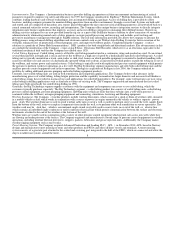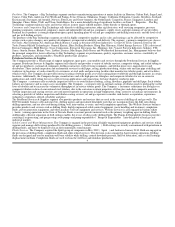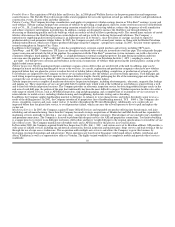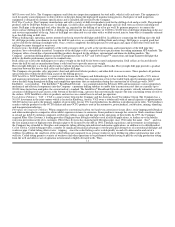National Oilwell Varco 2010 Annual Report Download - page 18
Download and view the complete annual report
Please find page 18 of the 2010 National Oilwell Varco annual report below. You can navigate through the pages in the report by either clicking on the pages listed below, or by using the keyword search tool below to find specific information within the annual report.
ITEM 1A. RISK FACTORS
You should carefully consider the risks described below, in addition to other information contained or incorporated by reference herein.
Realization of any of the following risks could have a material adverse effect on our business, financial condition, cash flows and results of
operations.
We are dependent upon the level of activity in the oil and gas industry, which is volatile.
The oil and gas industry historically has experienced significant volatility. Demand for our services and products depends primarily upon the
number of oil rigs in operation, the number of oil and gas wells being drilled, the depth and drilling conditions of these wells, the volume of
production, the number of well completions, capital expenditures of other oilfield service companies and the level of workover activity. Drilling
and workover activity can fluctuate significantly in a short period of time, particularly in the United States and Canada. The willingness of oil and
gas operators to make capital expenditures to explore for and produce oil and natural gas and the willingness of oilfield service companies to
invest in capital equipment will continue to be influenced by numerous factors over which we have no control, including:
the ability of the members of the Organization of Petroleum Exporting Countries, or OPEC, to maintain price stability
through voluntary production limits, the level of production by non-OPEC countries and worldwide demand for oil and gas;
level of production from known reserves;
cost of exploring for and producing oil and gas;
level of drilling activity and drilling rig dayrates;
worldwide economic activity;
national government political requirements;
development of alternate energy sources; and
environmental regulations.
If there is a significant reduction in demand for drilling services, in cash flows of drilling contractors, well servicing companies, or production
companies or in drilling or well servicing rig utilization rates, then demand for the products and services of the Company will decline.
Volatile oil and gas prices affect demand for our products.
Oil and gas prices have been volatile since 1972. In general, oil prices approximated $18-$22 per barrel from 1991 through 1997, experienced a
decline into the low teens in 1998 and 1999, and have generally ranged between $25-$100 per barrel since 2000. In 2008, oil prices were
extremely volatile oil prices rose to $147 per barrel in July 2008 only to fall into the $35-$45 per barrel range in December 2008. In 2009, oil
prices continued to be volatile, rising to the $70 per barrel range during the year. In 2010 oil prices continued rising to finish the year well above
$80 per barrel. Domestic spot gas prices generally ranged between $1.80-$2.60 per mmbtu of gas from 1991 through 1999 then experienced
spikes into the $10 range in 2001 and 2003. Prices generally ranged between $4.50-$12.00 per mmbtu during 2005-2008. In 2009 and 2010, spot
gas prices generally stabilized, dropping into the $3 per mmbtu range during 2009 before rising slightly in 2010 to finish the year just under $4
per mmbtu.
Expectations for future oil and gas prices cause many shifts in the strategies and expenditure levels of oil and gas companies and drilling
contractors, particularly with respect to decisions to purchase major capital equipment of the type we manufacture. Oil and gas prices, which are
determined by the marketplace, may fall below a range that is acceptable to our customers, which could reduce demand for our products.
18
























